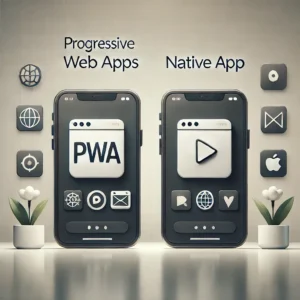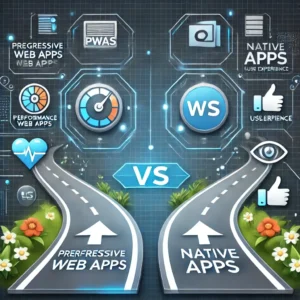In today’s digit al world, businesses need a strong mobile presence. But with so many options available, choosing the right path can be tricky. Two main contenders are Progressive Web Apps (PWAs) and native apps. This blog post will break down their key differences to help you pick the perfect fit for your business.
al world, businesses need a strong mobile presence. But with so many options available, choosing the right path can be tricky. Two main contenders are Progressive Web Apps (PWAs) and native apps. This blog post will break down their key differences to help you pick the perfect fit for your business.
What are PWAs?
Think of PWAs as websites on steroids! They offer an app-like experience, can be installed on your device’s home screen, and work offline (to some extent). Imagine browsing a clothing store’s website, adding items to your cart, and then completing the purchase – even without an internet connection!
What are Native Apps?
Native apps are the classic mobile applications you download from app stores like Google Play or the App Store.They’re designed specifically for a particular operating system (Android or iOS) and take full advantage of the device’s hardware and features.
The Pros and Cons: A Breakdown
PWAs:
Pros:
- Faster and cheaper to develop: PWAs leverage existing web technologies, making them a cost-effective option. Updates happen automatically through the web, eliminating the need for app store submissions.
- Cross-platform compatibility: One PWA works seamlessly across different devices (phones, tablets,desktops) without needing separate versions.
- Easy discovery: PWAs can be found through search engines, making them easily discoverable by potential users.
Cons:
- Limited functionality: PWAs might not have access to all device features like GPS or camera compared to native apps.
- Offline capabilities can be limited: While some features might work offline, full functionality might require internet access.
- App store visibility: PWAs aren’t featured in app stores, making discoverability through search engines crucial.
Native Apps:
Pros:
- Seamless user experience: Native apps are optimized for specific platforms, providing a smooth and responsive experience.
- Full access to device features: Native apps can leverage features like GPS, camera, and notifications more effectively.
- App store visibility: Gaining visibility in app stores exposes your app to a large potential user base.
Cons:
- Higher development cost: Building separate native apps for different platforms requires more time and resources.
- App store approval process: Submitting your app to app stores involves a review process that can take time.
- Updates require app store submissions: Updating a native app requires submitting a new version to app stores, adding an extra step to the process.
Which One Should You Choose?
The best choice depends on your business needs. If you need a simple, cost-effective solution with broad reach, a PWA might be a good option. However, if your app requires deep integration with device features or offers a complex user experience, a native app might be the way to go.

Consider these factors:
- App complexity: Does your app require advanced features or functionalities?
- Target audience: Who are you trying to reach? Are they primarily on one platform?
- Development budget: How much can you invest in app development?
In some cases, a hybrid approach might be ideal. You could launch a PWA for basic functionality and offer a native app for power users or those needing advanced features.
Ultimately, the key is to choose the platform that best meets your business goals and delivers a valuable experience for your users.
